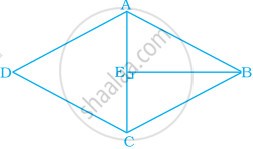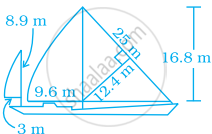Advertisements
Advertisements
प्रश्न
If perimeter of a rhombus is 100 cm and length of one diagonal is 48 cm, what is the area of the quadrilateral?
उत्तर

Perimeter of the rhombus = 100 cm
⇒ `4 xx` side = 100
⇒ side = `100/4` = 25 cm
Thus, each side of the rhombus = 25 cm.
Diagonals of a rhombus are perpandicular bisector of each other.
So, AO = OC = `48/2` = 24 cm
In Δ AOB,
We apply Pythagoras theorem,
AO² + OB² = AB²
⇒ 24² + OB² = 25²
⇒ OB² = 625 - 576 = 49
⇒ OB = 7 cm
So, DB = `2 xx "OB" = 2 xx 7` = 14 cm
Area of rhombus = `1/2 xx` (product of diagonal)
= `1/2 xx 14 xx 48`
= 336 cm²
संबंधित प्रश्न
If length of a diagonal of a rhombus is 30 cm and its area is 240 sq cm, find its perimeter.
Each side of a rhombus is 18 cm. If the distance between two parallel sides is 12 cm, find its area.
The area of the rhombus when both diagonals measuring 8 cm is
The height of the rhombus whose area 96 sq.m and side 24 m is
The figure ABCD is a quadrilateral in which AB = CD and BC = AD. Its area is ______.

What is the area of the rhombus ABCD below if AC = 6 cm and BE = 4 cm?

Area of a quadrilateral ABCD is 20 cm2 and perpendiculars on BD from opposite vertices are 1 cm and 1.5 cm. The length of BD is ______.
If the diagonals of a rhombus get doubled, then the area of the rhombus becomes ______ its original area.
Most of the sailboats have two sails, the jib and the mainsail. Assume that the sails are triangles. Find the total area of sail of the sailboats to the nearest tenth.

